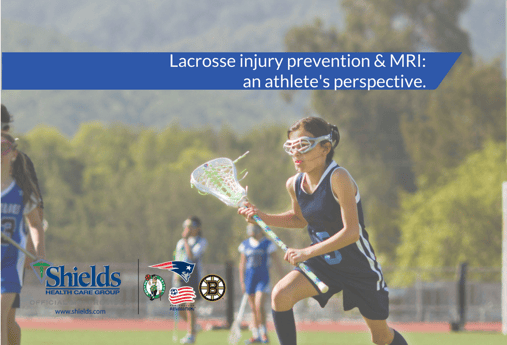
For many athletes, family members and fans of the increasingly popular sport, lacrosse, this is a familiar scenario. Tearing the ACL is an injury that can happen quite frequently in lacrosse due to a mix of speed, cutting, overtraining and the variation of playing surfaces these athletes encounter within the sport. The ACL is one of four major ligaments in the knee and it is crucial in stabilizing the knee when turning or planting, a common action in lacrosse.
As a lacrosse player for 14 years, including four years at Boston University where I was also team Captain, I have seen my fair share of ACL injuries in teammates and opponents. The causes of this injury can range anywhere from a high-impact blow to a “funny” landing on a fall. While I wouldn’t say there is a special formula to preventing an ACL injury, there are steps that my teammates and I were taught to better prepare our bodies to prevent injury and to recover quickly. Most important is warming up and recovery. Before you go out to a workout, practice, or game it is vital to perform a dynamic warm up to activate your muscles. Recovery is extremely important to keeping an athlete healthy. The important aspects of recovery are icing sore muscles, rolling out and stretching, eating a balanced diet, and getting the rest you need.
Tim Gleason, Strength and Conditioning Coach at TRG Performance, has trained a number of high school and college athletes and emphasizes the importance of strength training for injury prevention. He says, “Posterior strength and range of motion are extremely important for athletes. More specifically your hamstring strength versus quadriceps strength is vital.” When building your strength it is important to find the balance between your hamstrings and quadriceps. Gleason advises, “Hamstring curls are a great exercise. You can do hamstring curls with a machine, slide board, or TRX band and they should be done slowly taking between 3 and 5 seconds on each repetition. Lastly, mobility is important and can be created by stretching and rolling out quadriceps, hips, and hamstrings.”
Despite an athlete’s best efforts in injury prevention, they still happen. Most athletes who tear the ACL say it starts with a “pop” sound, like the snapping of a rubber band, followed by pain and swelling. If you think you may have an ACL injury or tear, you should get evaluated by a doctor as soon as possible. Your doctor will likely perform a number of stability tests including the Lachman test, the pivot-shift test, and the anterior drawer test, all designed to determine if there is instability in any of your ligaments. If the doctor feels instability, he or she will likely request imaging of the knee – typically an MRI – to diagnosis or rule out a tear. MRI is the preferred imaging technique because of its ability to create an amazingly clear, detailed picture of the ligaments inside the knee. When you have an MRI for an ACL injury, there are a few things to keep in mind:
-
Get an appointment as soon as possible. Diagnosis is the first step to recovery and getting an MRI appointment quickly is crutial. Shields MRI offers same and next day appointments throughout their network.
- Look for a radiologist who is specialized in musculoskeletal and orthopedic MRI. The right diagnosis for a small tear or ruling out a tear at all is dependent on the doctor (radiologist) reading the MRI scan. Shields MRI’s radiology team has radiologists sub-specialized in these areas.
-
Comfort is important. Typically an MRI of the knee can take up to 30 minutes. During this time, you will need to lay still to capture the best images. This can be challenging when you are in pain and injured! Look for a short-bore MRI with a larger opening so that you have the majority of your body outside of the MRI “tube”. Shields centers offer many of these comfortable options – all you have to do is ask!
After your MRI, the radiologist will report the findings to your physician and if you do have an ACL tear, they may recommend surgery or physician therapy. Both are common for an ACL tear or injury and your physician will determine the best course of treatment to get you back in the game.
The road to recovery is not necessarily easy with either surgery or therapy. The recovery can be as quick as six months, but can be longer than a year for others. Every athlete heals at a different rate, so do not get discouraged if your recovery takes longer than someone else’s recovery. One story of an ACL injury that stands out to me is of Mallory Collins, a Division 1 athlete lacrosse player. She had a standout freshman season being named America East Rookie of the year when one week prior to her sophomore start, she suddenly tore her ACL playing in a scrimmage. Her recovery took about a year to come back and she had to have an additional surgery; but slowly she recovered to become the leading scorer for hern_acl/page5.htm team junior year and was named to the Second All-Patriot League Team. Mallory said “One of the most difficult parts of recovery is getting your leg extension back. It is difficult and painful, but taking my first strides post surgery was extremely rewarding.” Like most ACL injuries, Mallory’s was unexpected. With the right diagnosis, treatment and rehab, you can get back to playing – even stronger than before.
From my experience and lacrosse athletic career, I saw many injuries, but I also saw all of my teammates bounce back because they had the right healthcare and positive attitude. During an ACL injury there will be ups and downs like any other injury, but it is essential to remain positive and remember how much you love playing your sport.
Resources:
http://www.laxmagazine.com/genrel/101013_how_to_get_ahead_of_lacrosse_acl_problem



